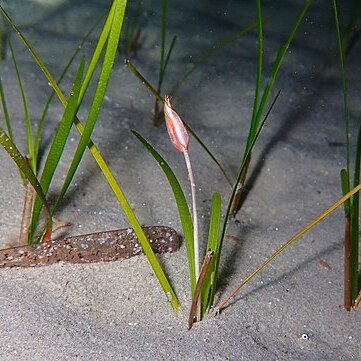Submerse aquatic herbs. Rhizome creeping, monopodial, with many vascular bundles; each node with 1– 5 branched roots and a short erect stem bearing 2– 7 leaves; scales ovate, scarious. Leaves with the sheath compressed, bi-auriculate, ligulate, persisting longer than the blade, leaving a scar when shed and giving the stem an annular appearance; blade linear, margins entire but for the distal part which becomes serrulate or spinulose, apex ± toothed; nerves 7– 17, with perpendicular cross-veins. Flowers solitary and terminal, enclosed in a leaf similar to others, a bud in the axil of the penultimate leaf lengthening to give rise to a sympodium. Staminate flowers stalked, of 2 dorsally connate anthers, attached at the same height, each crowned by subulate tip. Pistillate flowers sessile or shortly stalked, of 2 free ovaries each with a short style, distally bifid. Fruit with stony pericarp, laterally compressed, semi-circular to elliptic in outline, with dorsal ridges and a beak.
Marine, submerged, sometimes intertidal herbs. Rhizome herbaceous, monopodially-branched, with 1 or more branched roots and an erect stem at each node; scales scarious, ovate. Stem with 2–5 leaves. Leaf sheath compressed, persisting longer than leaf blade, leaving an open or closed circular scar. Leaf blade linear, flat, often narrowed at base, entire; apex rounded, serrulate or spinulose; longitudinal veins 7–22. Flowers solitary on terminating erect shoots, enclosed by a normal leaf. Male flowers stalked; anthers at same level, dorsally connate, each with a subulate appendage. Female flowers shortly stalked; style short, divided into 2 stigmas. Fruit usually 2, hemispherical to semi-ovoid or ellipsoid, laterally compressed; pericarp stony, smooth, beaked. 2n = 14, 28, fide C.den Hartog et al., Pl. Syst. Evol. 156: 58 (1987).
Rhizomes branched, rooting at nodes. Leaves 2-7 together on short erect shoots, flattened, linear, 7-17-veined, margin entire or dentate; sheaths auriculate, ligulate. Flowers solitary and terminal. Perianth absent. Male flowers pedunculate; anthers 2; pollen filiform. Female flowers sessile or subsessile; styles divided into 2 filiform stigmas. Fruitlets laterally subcompressed, with bony pericarp, beaked.

